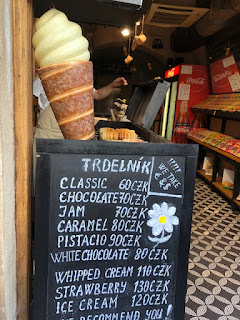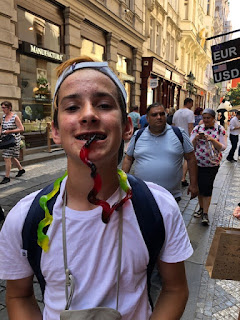We started our day out at the Salt Mines in Krakow, and we were all amazed. We all agreed that it was way more than what we expected. It was a long tour all through the tunnels which have been dug underground by the salt miners centuries ago.
We started 180 feet below the surface (but still above sea level since we were on a mountain). The salt export started over 700 years ago and was considered as valuable as gold at some times because of its use for preservation of food.
The Krakow Salt Mines stopped exporting salt in 1996 as it as become less valuable with the invention of more and more technology.
Legend says the Princess of Hungary, now known as Saint Kinga, was coming to marry the Duke of Poland and wanted to bring something special with her. She did not know how to move the salt mines, so she threw her engagement ring into the salt mines of Hungary. Later, when she arrived in Krakow, she ordered the men to dig in a specific place, and when they struck the rock, they chipped off a piece and handed the salt to her with her ring! They then knew she had brought something special to them! So, she is now considered the patron saint of salt miners!
Click here for a more detailed description of the legend.
It felt a little like Willy Wonka was taking us through his chocolate factory as we stopped at a wooden door and were told to touch the walls and lick our fingers to prove that it really was salt! (I did not really lick the wall, but I cannot speak for anyone else! Sorry! :) Absolutely everything in the mines was made of salt. It was truly incredible!
There are 40 different chapels in the salt mines. They were considered important because working in the mines is a dangerous job between the gases and water. So, the workers needed places to come to pray. The picture above is of Holy Cross chapel which was built in 1860.
Saint Kinga's Chapel was unreal! Everything is made from salt...the chandeliers, and even the beautiful floors that were beautifully carved. The guide told us that the humidity is monitored in the room to keep things properly preserved, but he said that the floors have not been refurbished since they were first created in the 1800's!
Look at the floors! Isn't that amazing??
Also in Saint Kings's chapel were carved replica's of famous paintings like this one - DaVinci's "The Last Supper."
And to finish off our tour of the mines, instead of walking back up the 400 steps we came down, we rode a very interesting elevator back up! It's hard to describe, but the Willy Wonka feel did come back!!
And, as usual...you pay for a fun activity and the kids have the most fun with the free water spraying at the exit!!?!
--------------------------------------------------------------------------------------------------------------------------
We drove straight from the salt mines to Auschwitz where we ate lunch at a canteen before entering the former camp. It was a heavy afternoon, and some of the group had a hard time with what we saw, but overall, it was a good lesson in history. No book or website could ever teach what we learned as we walked the same roads and into the same buildings as the 1.3 million people who were deported to Auschwitz throughout its existence from 1940 to 1945.


We stood in the exact place where the people got off the trains which they had been locked up in for possibly a week with no bathrooms and food. They were told to put down their belongings which they had already placed their names on and to form lines of men and women (with children). They were told this was just to separate them for showers and then they would see each other. From there, German doctors would go through the line and tell the people which way to go based on their health and level of fitness. Those who were deemed fit were sent to be groomed, hair shaved and given prison uniforms before setting off to work.
The people who were not seen as beneficial were sent directly to the "showers". They were told to take off their clothes first and then walk into the shower rooms. In these rooms, the soldiers would pour the chemical agent Zyklon B (made for poisoning rats) directly into the chamber where the people were. It would take only 15-20 minutes for everyone in the chamber to die - depending on how close they were to the chemical.
Their belongings were sorted (by prisoners) and then shipped off to be sold for other uses. After people were killed, their gold teeth and jewelry were removed and sent to the
Deutsche Reichsbank to fund the Nazi party!
We walked through many rooms where belongings were piled beyond belief....and these were just the ones that had not been shipped off or burned before the liberation of the camp!
It was extremely difficult to see all of their belongings -
shoes, kitchen ware, clothing, suitcases, children's clothes, and especially hair! The people who were immediately killed in the chambers had not yet had their heads shaved. Their hair would be cut off (afterward) and sold to make textiles from - like rolls of material, things you would use thread for! I can't imagine how many items were made from that hair and no one even knew it! We saw two tons of hair (mostly braids) piled up in one room. For some of us, that was the most difficult thing to see. It is just too much to imagine what people went through.
We walked through the camp (Auschwitz One) and were in silent awe. I just can't write everything we saw. It was completely horrible and unthinkable. We just cannot imagine how any person could do such things.
After almost two hours at Auschwitz One, we rode the bus a few miles over to Birkenau, aka Auschwitz Two which we were told was never a work camp - strictly a termination camp.
This is a train like one they would have come on with over 100 people crammed inside.
Latrines where prisoners were allowed to come only twice a day and for a very limited time.
Bunk beds lined the barracks where 800 people were expected to sleep in an area designed for 400 -in temperatures 30 degrees below 0 and throughout the hot summers without any insulation!
- Over 230,000 children were murdered at Auschwitz.
- Over 400,000 people were registered as prisoners at the camp.
- On average, women lived 3-4 months one entering Auschwitz and men lived 7-8 months.
- 6 million Jews were murdered in WWII; 1 million of them in Auschwitz alone
- The camp was liberated on January 27, 1945.
- About 7000 people were found alive in Birkenau, but many died soon after because they were too ill!
- Only about 15% of the Auschwitz war criminals were brought to justice. Many fled to S. America.
- In July 1947, the government decided to preserve Auschwitz, and Polish survivors were the first employees of the museum.
After our visit to both camps, we boarded the bus and had a pretty quiet one hour drive back to the restaurant for dinner. Many of us napped and felt more upbeat when we arrived at dinner. Dinner was a typical Polish dinner with soup, fried chicken, potatoes, and a type of coleslaw. And, of course, we finished it up with a scoop of ice cream and apple pie!
We celebrated Carson's 14th birthday at dinner and enjoyed visiting with the whole group!
Tomorrow, we leave for Hungary with a short stop in Slovakia!















































































